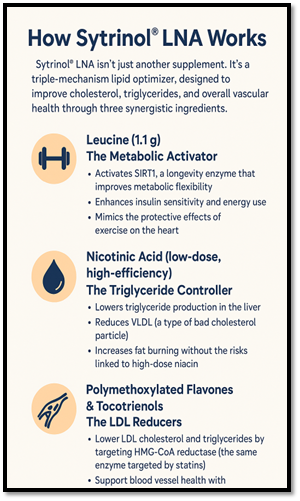Sytrinol
Beyond Statins: A Smarter Approach to Heart Health with GLP-1s + Sytrinol® LNA
For decades, statins and niacin have been the go-to options for lowering cholesterol. But the truth is, both have serious limitations:
- Statins often cause muscle pain, fatigue, and other side effects.
- Niacin can only work at very high doses—doses that most people can’t tolerate.
- Low-dose alternatives often don’t make a real impact.
- And worst of all, many of these treatments don’t address the root causes of poor heart health.
That’s why forward-thinking practices like
Confidia Health Institute are turning to a smarter combination:
GLP-1 medications (like Tirzepatide) plus
Sytrinol® LNA.
This dual-pathway approach tackles heart health from both the metabolic level and the molecular level—without the trade-offs of statins.
The Dual Power of GLP-1s + Sytrinol® LNA
GLP-1 medications (such as semaglutide and tirzepatide) are already well-known for improving blood sugar and helping with weight loss. Additionally, they also enhance the body’s lipid-buffering capacity, meaning they help fat stay in the right places (like adipose tissue) instead of building up in organs or blood vessels. This lowers inflammation and cardiovascular risk.
When combined with
Sytrinol® LNA, the benefits go much deeper:
- Sytrinol’s natural compounds (polymethoxylated flavones and tocotrienols) directly lower LDL cholesterol and triglycerides.
- Together, GLP-1s and Sytrinol LNA work to reduce cardiovascular risk at both the system-wide and cellular levels.

Why ApoB Matters Most
While many people focus only on LDL or “total cholesterol,” the most accurate predictor of heart disease is actually ApoB—a protein found in the particles that cause plaque buildup.
Clinical research shows that Sytrinol® LNA can help:
- Reduce ApoB levels
- Improve cholesterol ratios (higher HDL, lower LDL)
- Lower triglycerides
- Enhance metabolic flexibility
When used alongside GLP-1 therapy, this protocol can significantly cut the risk of heart attacks, strokes, and vascular disease.
Why This Approach Works When Others Don’t
Unlike statins or high-dose niacin, this protocol:
- Uses natural nutrient signaling to optimize lipid metabolism.
- Avoids common side effects like muscle pain, insulin resistance, or flushing.
- Provides deeper cardiovascular protection by targeting multiple pathways at once.
In short, it’s a smarter, safer, and more effective way to protect your heart.
Patient-Friendly FAQ
- What is Sytrinol® LNA?
It’s a clinically developed formula that combines leucine, nicotinic acid (at safe, low doses), and plant compounds (flavones and tocotrienols) to optimize cholesterol and triglycerides naturally. - How is this different from taking a statin?
Statins work only on one pathway and often cause side effects. Sytrinol® LNA works on three pathways at once—improving cholesterol, triglycerides, and metabolic health—without muscle pain or fatigue. - Can I use this with a GLP-1 medication like semaglutide or tirzepatide?
Yes. In fact, the two work best together. GLP-1s improve how the body stores and uses fat, while Sytrinol® LNA directly lowers cholesterol and triglycerides. - How soon will I see results?
Some patients notice changes in energy and metabolism within weeks. Blood tests usually confirm improved lipid markers after 8–12 weeks. - Is it safe?
Yes. The ingredients in Sytrinol® LNA are well-studied and well-tolerated. Always check with your doctor before making changes to your protocol.
Take the Next Step with Confidia Health Institute
Dr. Greene and his team specialize in advanced, functional medicine—helping patients lower cardiovascular risk, optimize metabolism, and extend their healthspan using evidence-based, precision protocols.
If you’re ready to go beyond statins and finally optimize your heart health at the root level, Sytrinol® LNA protocols are available through Dr. Kevin Greene and Confidia Health Institute.
👉 Ask Confidia Health Institute about GLP-1 + Sytrinol® LNA today—and take the first step toward statin-free, heart-smart health optimization.
